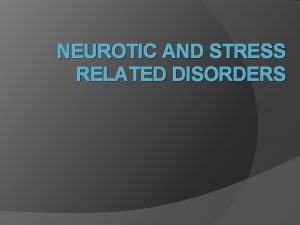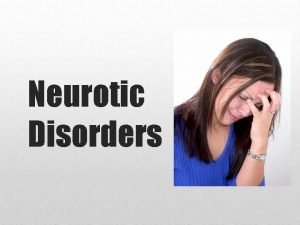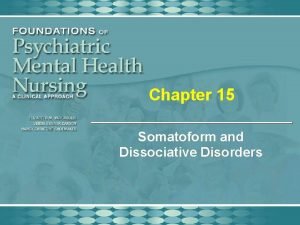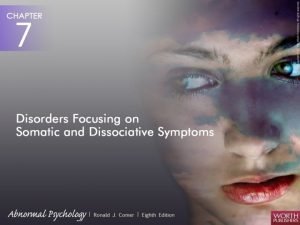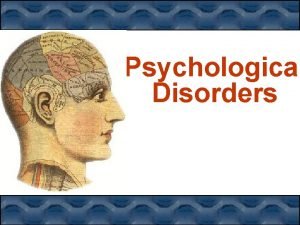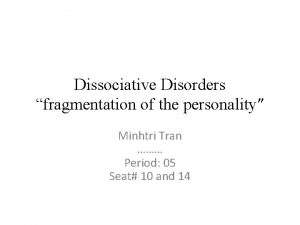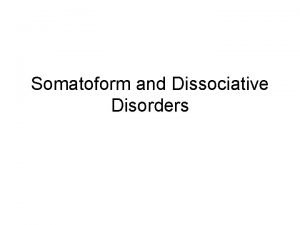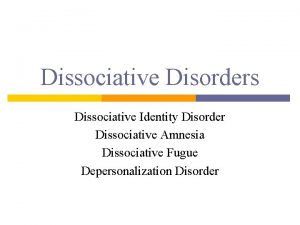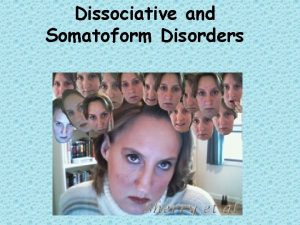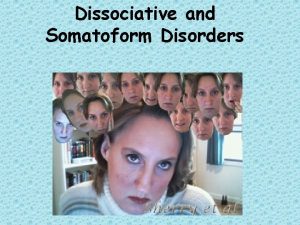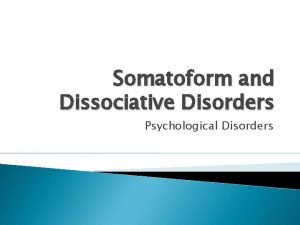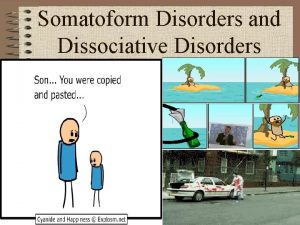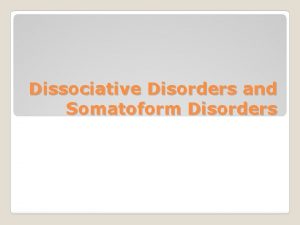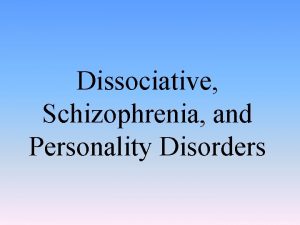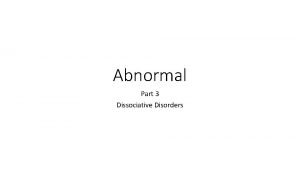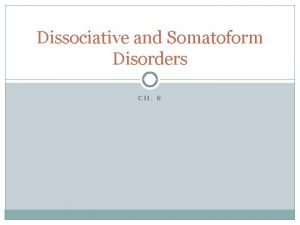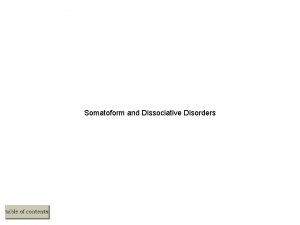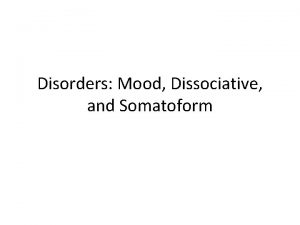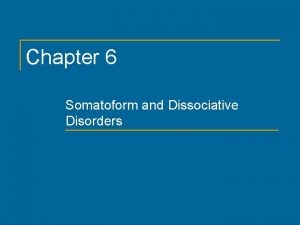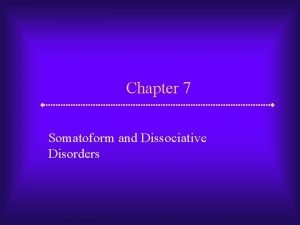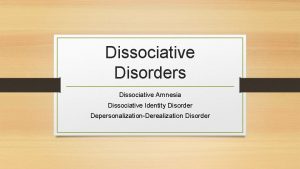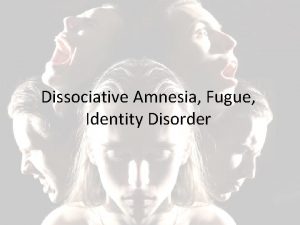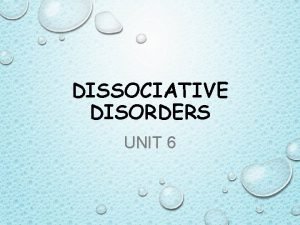Somatoform and Dissociative Disorders 7 Chapter 5 Somatoform





















- Slides: 21

Somatoform and Dissociative Disorders 7 Chapter 5

Somatoform Disorders Soma = Body Preoccupation with ___________ __ Physical No complaints identifiable medical condition

Hypochondriasis Clinical Description Physical complaints without ________ Severe _____ about the possibility of having a serious disease Strong disease conviction DSM –IV criteria preoccupation with fears of having, or the idea that one has, a serious disease based on the person’s misinterpretation of bodily symptoms Medical reassurance does not seem to help The preoccupation with fears of having a serious disease is not of delusional intensity and not a circumscribed concern about appearance Preoccupation causes significant distress or impairment in social, occupation, or other important areas of functioning Duration of disturbance at least 6 months May not be accounted for by other disorders

Hypocho ndr iasis Causes Cognitive perceptual distortions Familial history of illness- genetic vulnerabilities, overreaction to stress, tendency to view negative life events as unpredictable and uncontrollable, modeling Culture Chinese- koro India- dhat Statistics Good prevalence data are lacking Onset at any age 6. 7% median rate Female : Male = 1: 1

Hypochondriasis Treatment Challenge illness-related misinterpretations Provide more substantial and sensitive reassurance/ CBT Stress management and coping strategies

Somatization Disorder Extended history of physical complaints before age 30 Substantial impairment in social or occupational functioning Concern about the symptoms, not what they might mean Symptoms become the person’s identity Rare condition Onset usually in adolescence Mostly affects unmarried, low SES women

Somatization Disorder DSM-IV History of complaints, before age of 30 with significant impairment in social, occupational, or other important areas of functioning Pain related to 4 main sites or functions 2 gastrointestinal symptoms One sexual symptom One pseudo-neurlogical symptom Either: cannot be fully explained by known general medical condition or effect of substance OR if related to general medical condition, physical complaints or resulting social or occupational impairment are in excess of what would be expected from the history, physical examination or laboratory finding Symptoms are not produced or feigned

Somatization Disorder Statistics Rare 4. 4%; 16. 6% in medical settings Onset = adolescence Female : male = ~2: 1 Unmarried, low SES Chronic course

Somatization Disorder Causes Injury during childhood Familial history of illness Relation with Antisocial Personality Disorder Share a neurobiologically-based disinhibition syndrome weak behavioral inhibition system that does not control the behavior activation system -

Somatization Disorder Treatment No treatment exists with demonstrated effectiveness Assign “gatekeeper” physician Reduce supportive consequences of talk about physical symptoms

Convers io n Disorder Physical malfunctioning Lack physical or organic pathology Malfunctioning often involves sensory -motor areas Persons show “la belle indifference” Retain most normal functions, but lack awareness

Conversion Disorder Freudian psychodynamic view is still popular Emphasis on the role of past trauma and conversion Repression of unacceptable conflict Primary gain- Secondary gain Differences: conversion disorder, actual illness, malingering (faking), & factitious disorder (faking w/o obvious cause), factitious disorder by proxy (caregiver making other’s sick)

Conversion Disorder Rare condition, with a chronic intermittent course Seen primarily in females Onset usually in adolescence Treatment Similar to somatization disorder Core strategy is attending to the trauma Remove sources of secondary gain Reduce supportive consequences of talk about physical symptoms

Dissociative Disorders Involve severe alterations or detachments Affects identity, memory, or consciousness Depersonalization – Distortion is perception of reality Derealization – Losing a sense of the external world Severe and frightening feelings of unreality and detachment Feelings dominate and interfere with life functioning

Depersonalization Disorder Facts and Statistics High comorbidity with anxiety and mood disorders Onset is typically around age 16 Usually runs a lifelong chronic course Causes Cognitive deficits in ____________, __________ Such persons are easily distracted Treatment Little is known

Dissociative Amnesia & Dissociative Fugue Dissociative Amnesia Includes several forms of psychogenic memory loss Most common dissociative disorder Generalized vs. localized or selective type Dissociative Fugue Take off and find themselves in a new place Unable to remember the past Unable to remember how they arrived at new location Often assume a new identity

Dissociative Amnesia & Fugue Usually begin in adulthood Show rapid onset and dissipation Occur most often in females Causes Little is known ______and ______can serve as triggers Treatment Most get better without treatment Most remember what they have forgotten

Dissociative Trance Disorder Dissociative symptoms and sudden changes in personality Changes often attributed to possession by a spirit Presentation varies across cultures More common in females than males Causes Often attributable to a life stressor or trauma Treatment Little is known

Dissociative Identity Disorder (DID) Adoption of several new identities (as many as 100) Identities display unique behaviors, voice, and posture Alters – Different identities or personalities Host – The identity that keeps other identities together Can it be faked? Ø Hillside strangler case Ø Controversial diagnosis

Dissociative Identity Disorder (DID) Average number of identities is close to 15 Ratio of females to males is high (9: 1) Onset is almost always in _________ High comorbidity rates & lifelong, chronic course Considered rare

Dissociative Identity Disorder (DID) Causes Histories of horrible, unspeakable, child abuse Closely related to PTSD Mechanism to escape from the impact of trauma Treatment Focus is on reintegration of identities Identify and neutralize cues/triggers that provoke memories of trauma/dissociation
 Types of somatic disorder
Types of somatic disorder Neurotic stress related and somatoform disorders
Neurotic stress related and somatoform disorders Neurosis
Neurosis Nursing care plan for somatoform disorder
Nursing care plan for somatoform disorder Somatoform disorders
Somatoform disorders Dissociative disorders
Dissociative disorders Types of dissociative disorders
Types of dissociative disorders Derealization quotes
Derealization quotes Somatoform disorder
Somatoform disorder Gangguan somatoform
Gangguan somatoform Carpopedal spasm panic attack
Carpopedal spasm panic attack Epidemiologi gangguan somatoform
Epidemiologi gangguan somatoform Associative and dissociative social process
Associative and dissociative social process Chapter 8 skin disorders and diseases review questions
Chapter 8 skin disorders and diseases review questions Chapter 6 musculoskeletal system
Chapter 6 musculoskeletal system Chapter 46 digestive and endocrine disorders
Chapter 46 digestive and endocrine disorders Chapter 29 endocrine and metabolic disorders
Chapter 29 endocrine and metabolic disorders Chapter 21 mental health diseases and disorders
Chapter 21 mental health diseases and disorders Chapter 18 eating and feeding disorders
Chapter 18 eating and feeding disorders Chapter 17 reproductive system diseases and disorders
Chapter 17 reproductive system diseases and disorders Chapter 15 nervous system diseases and disorders
Chapter 15 nervous system diseases and disorders Chapter 15 anxiety and obsessive-compulsive disorders
Chapter 15 anxiety and obsessive-compulsive disorders

